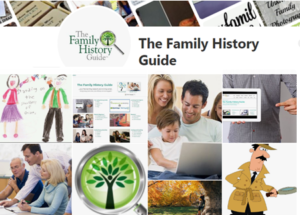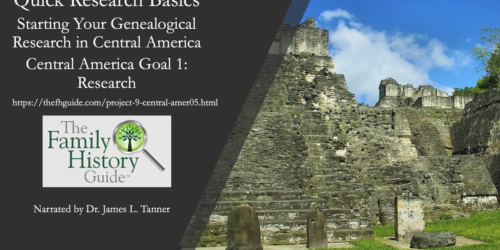Why Accuracy is so Important in Genealogy and Family History
 Many visitors to The Family History Guide are new to genealogy and family history. There are a lot of misconceptions about why record sources and citations are so important. Some people feel that if a relative passed on a story it should be good enough. What we sometimes don’t consider is that those stories may not be accurate. Most people don’t purposely embellish old stories, but it happens because they forget the details of stories from the past and dates, places. Consequently, actual events may be recorded improperly.
Many visitors to The Family History Guide are new to genealogy and family history. There are a lot of misconceptions about why record sources and citations are so important. Some people feel that if a relative passed on a story it should be good enough. What we sometimes don’t consider is that those stories may not be accurate. Most people don’t purposely embellish old stories, but it happens because they forget the details of stories from the past and dates, places. Consequently, actual events may be recorded improperly.
Family Search says this, “A source is a historical record, such as a picture, journal, Bible, document, or another item that contains evidence about your family history. Sources are critical to the genealogical process for documentation and discovery. In Family Tree, you can attach sources to people, couple relationships, and parent-child relationships.” To learn more about record sources and citations go to thefhguide.com for more information. Select FamilySearch from the dropdown menu on the Homepage. Select Project 1 Family Tree. Then select Adding Sources. There you will find a lot of great information about how this is to be done correctly for our family members and ancestors.
Even though the living people pages are still private, recently FamilySearch has allowed us to add sources to those that are living that no one else can see but you. This is really a great idea and a welcome change. This was announced as a new feature by Ron Tanner at Rootstech 2019 (go to 14:50) spot on the time bar on the link for specific info on adding sources to living people) where he shared the latest changes on FamilySearch/Family Tree. Once a person is deceased and that change is made on their Person Details page in FamilySearch/FamilyTree, from living to deceased, the work you have added in advance with those sources will be available to all. Once a person has died their information automatically becomes public. I did this on myself and my husband but was not able to add our children. It appears they are still working on this feature of adding records, photos, and stories for the living in our families.
Speaking of living people in our families, one thing I like to do is this: on the day of any big event in the lives of my relatives I make it a practice to add it to their pages on FamilySearch the exact same day. Our family history work is never done. This work is dynamic and changing all the time with births, marriages, and deaths. When you add in all the technology that has made so many things available to us on the Internet we can see that this work is never static.
FamilySearch alone adds more than a million and a half records to their database daily. Daily! Then think of all the other big databases like Ancestry, FindMyPast, My Heritage, Geneanet and American Ancestors, to name a few, that are also doing the same. There is no way our family history work will ever be done. There is always something to do to validate our entries on Family Tree. This is not meant to be discouraging but rather to be encouraging. As we establish our own practices to check back on people that we don’t have validated information for at this time, our record attachments will improve. We should do something on a regular basis. This will bring more hope that eventually, the records will continue to be added, creating a more accurate and acceptable world family tree. This is why collaboration with others whom we share ancestors with is so important. In a previous post, I discussed collaboration in more detail.
So how does the genealogical community establish rules that help us be consistent in validating information on all the various family trees available to the public since the digital age has become so huge in Family History? One way is the adhere to The Genealogical Proof Standard established by 1997 by The Board for Certification of Genealogists. It’s used to create sound, credible genealogical proof statements, and gives genealogists a standard to measure conclusions against. The Genealogical Proof Standard includes the following five steps: 1. Do a reasonably exhaustive search; 2. Complete accurate source citations; 3. Resolve conflicting evidence; 4. Analyze and correlate information; 5. Write a coherent conclusion. For more information go back to the Homepage of The Family History Guide. Select Project 1. Family Tree. Once again select Adding Sources from the top of the page. Choose Choice #1 and then #6. That is all about The Genealogical Proof Standard. Keep in mind also that The Genealogical Proof Standard is used by many people, not just Family Search users. The Internet is replete with information on it.
 One thing I appreciate about The Family History Guide is we can stay right on the website without having to go all over the Internet to find what we need. Staying on one website that has what we need to be successful just makes sense. It definitely makes this work easier, more efficient and much more enjoyable. It is convenient and time-saving. Once we actually start to use it, we begin to trust the value of the Family History Guide. When that happens our knowledge and confidence will grow immeasurably.
One thing I appreciate about The Family History Guide is we can stay right on the website without having to go all over the Internet to find what we need. Staying on one website that has what we need to be successful just makes sense. It definitely makes this work easier, more efficient and much more enjoyable. It is convenient and time-saving. Once we actually start to use it, we begin to trust the value of the Family History Guide. When that happens our knowledge and confidence will grow immeasurably.
Every effort is made to keep The Family History Guide accurate and up to date in this ever-changing discipline called family history. If you ever see anything that needs updating, help us out by letting us know. It is our desire at the Family History Guide to make your experiences better with an organized way of learning and doing your family history. Our contact information is found on the Homepage under Misc. dropdown menu. Or you can leave comments on the blog posts or on our social media pages as well. Remember that when you add something to someone’s Person Details page, the next right thing is to document it and then make a citation that shows another person exactly where you found that information That way they can go to that citation and find the documentation quickly. The more you do this on your tree the less likely you will have others changing your work. No sources leave you wide open to a whole lot of hassles you probably don’t want to have.





